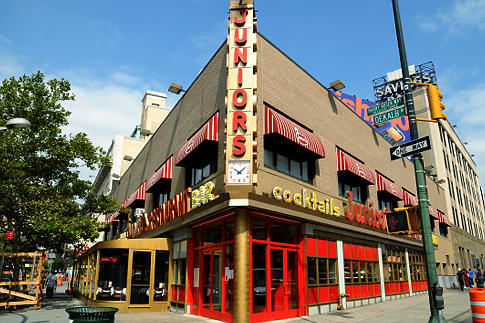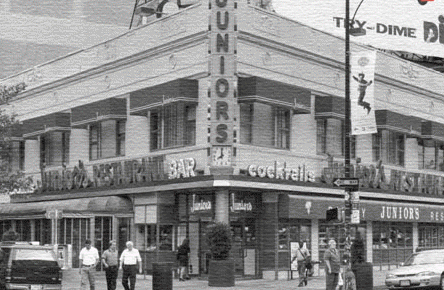
Junior's today.
The 82-minute independent documentary, My Brooklyn, directed by Kelly Anderson, presents a comprehensive historical overview of the transformation of the Fulton Mall, the last “stubborn holdout” against gentrification. Anderson, a self-described gentrifier who began her residency in Fort Greene in 1999 and later lived in other Brooklyn nabes, chronicles the impact of the 2002 rezoning.
The rezoning allowed much taller residential buildings in a traditionally commercial area near Fulton Mall, resulting in the construction of about 19 luxury residential buildings comprising thousands of units. They include the towering condos Toren, Avalon, and D’Oro along Flatbush Avenue and the conversion of the nearby former Verizon and Williamsburgh Savings Bank buildings.
Fulton Mall is the third most profitable commercial area in New York City after Fifth and Madison avenues in Manhattan. Much more important than the profitability rank of the area is the level of comfort for residents and shoppers who indulge in their particular fashion designers, affordable eateries, history books, and music not found elsewhere.

Junior's of yore.
The responses to Anderson’s interviews reveal a chasm between viewpoints about the Fulton Mall that breaks down along racial lines. The white shoppers interviewed elsewhere in Brooklyn use derogatory language, describing Fulton Mall as “rundown” and “not aesthetically appealing,” adding “make it go away” and “you can’t polish a turd.” But the Fulton Mall shoppers, mostly people of color, describe it using terms like “urban feel,” “harmony,” “felt welcomed wherever they went,” and “all the little things.”
In the film, historian and Brooklyn resident Craig Wilder describes the history of Brooklyn neighborhoods whose future was pre-determined based on racial, not economic, dynamics. Both whites and people of color attempted to flee the city during the 1970s, when the manufacturing industry collapsed.
However, while white families were able to obtain mortgages to move to the suburbs, blacks and Latinos had enormous difficulty obtaining them and were essentially “financially quarantined” by redlining of many Brooklyn communities for more than 30 years. This “ghetto action” was engineered through segregation and the reduction of public services.
Those unable to leave “stuck it out” and were mostly entrepreneurs of color who managed to successfully create a vibrant and profitable business community. Those entrepreneurs saved downtown Brooklyn at a time when no one else wanted to invest there.
Within the Fulton Mall area is Albee Square, located on public land where a new retail and residential complex will be built and whose expensive products and services are incongruent with the local tastes, according to the documentary. After the sale of the lease to private interests, long-time businesses were given a mere 30 days to vacate the premises.
Adding insult to injury, they were not even permitted to post signs informing their clientele of their new location. Suddenly those non-white businesspeople who were economic prisoners for 40 years were being forcibly displaced—to vanish: in 30 days.
As Wilder further explains, the new developers provide little giveback to the community while enjoying vastly reduced taxes. The so-called affordable housing median income, which is $130,000 per household, is beyond the reach of most local residents. Wilder adds that when government gives monies to developers, they are called long-term (15-20 year) tax subsidies. When the same government provides financial support for people in need, it’s called welfare.
Wilder explains that gentrification comes from “gentry,” meaning “those of high social class;” in other words, the elite. Thus the Fulton Mall development was a result of deliberate under-the-radar planning conceived years ago and legally shielded from public scrutiny and oversight. For example, according to the city government organization chart, the city’s Economic Development Corporation reports directly to the Mayor, which means that the public hearings were nothing more than a formality; decisions were a fait accompli. Disturbingly, government officials and real-estate developers at these public hearings used the same linguistic language to describe and explain the changes to residents and business owners.
The purpose of government vis a vis development is to independently assess the benefits while protecting the people, not to collaborate with private interests. This runs counter to the 2004 Pratt Plan, (officially entitled “New Strategies for Preservation and Planning”) by the Pratt Center for Community Development. The plan recommends planning and design work for an improved Fulton Mall that serves the needs of all Brooklynites and assists small minority businesses.
Brooklyn is the “Lebensraum” for the wealthy or “Bloomberg’s Brooklyn,” through the insidious collaboration between government and private developers.
Albert Goldson is an Architectural & Engineering Contract Manager specializing in transportation mega-projects, energy, and urban planning. He has also been a resident of Williamsburg for ten years and is an internationalist and avid jazz aficionado.
agoldson888@gmail.com
Leave a Reply